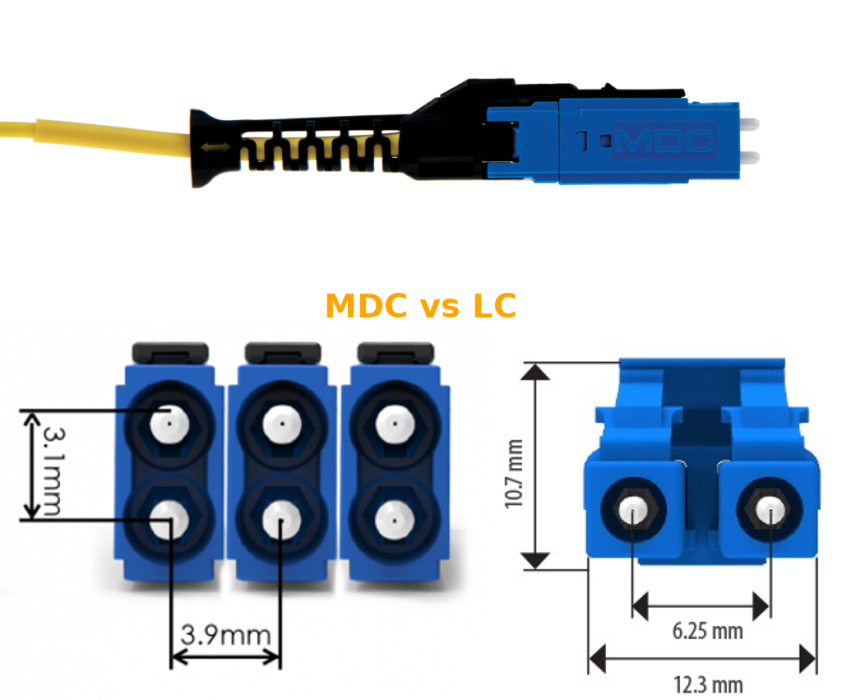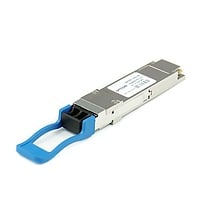Blog, Network Cabling, Optical Transceiver
What is MDC Connector: A Beginner’s Guide
Optical communication generally requires space-saving, cost-saving, and high-density connectors. In recent years, USconec has designed a new MDC connector that meets such needs. This guide will give a detailed introduction to the MDC connector.
What is an MDC connector?
MDC connector, Mini Duplex Connector, a two-fiber Very Small Form Factor (VSFF) connector, is a high-density fiber optic connector for singlemode or multimode fibers. The MDC uses the same 1.25mm ferrule as the LC connector. And it is minimal compared to the LC connector. The MDC connector can use a three-port adapter to connect to the standard panel openings for the LC connector, which means three times the density compared to the LC connector.

While offering the benefits of high density, small size, and easy installation, the MDC connector also supports transceiver multi-source agreements (MSAs). It supports four separate MDC fiber cables in a QSFP-DD or OSFP module and two separate MDC fiber cables in an SFP-DD module.
Key features of MDC connector
1. Technical Specifications
| Ferrule Diameter | 1.25 mm (same as LC connectors) |
| Cable Diameter | Ø 1.2 to 2.0 mm |
| Insertion Loss | 0.12 dB mean (random mating, ≥97% connectors) |
| Return Loss | ≥ 55 dB (UPC polish); ≥ 65 dB (APC polish) |
| Operating Temperature | -40°C to +85°C |
2. Small-size & High-density
MDC connector is small while providing three times the fiber density of an LC connector. It supports 216 duplex connectors and 432 fibers in a single rack unit (1RU).
3. DirectConec™ Push-Pull Boot
DirectConec™ Push-Pull Boot makes it easy to insert and remove, even in connector-dense panels, without affecting neighboring interfaces.
4. Easy Polarity Management
Three steps to achieve Polarity reversal.
- Pulling out the boot
- Rotate the connector housing 180 degrees
- Push the boot back in
There is no need to expose or twist the fiber. Quick, easy, and error-free process.
5. Industry Standards
Compliance with Telcordia GR-326 and TIA-568 standards ensures the MDC’s stability in harsh environments while meeting existing infrastructure and equipment compatibility.
6. Supports Multiple Modes
It supports multiple fiber propagation modes, including multimode, singlemode, and singlemode-APC. It can meet different network requirements with good flexibility and scalability.
Applications of MDC Connector
1. Data Centers
Data centers have huge data processing and storage needs, and MDC supports high-density cabling, which meets the needs of high-performance transmission while effectively saving space and costs.
2. Telecom network
The MDC has a compact design and offers high performance for telecom network (e.g., FTTH, CATV) infrastructures, especially in scenes that require high speed and space utilization.
3. Optical Communication Architectures
MDC connectors are compatible with current transceiver formats like OSFP, QSFP-DD, and SFP-DD, supporting seamless integration into optical communication architectures.
We provide a broad line of 100G/400G transceivers with the regular LC or MPO connector. Take a look at our products below.
Considerations
- Adoption in Legacy Systems: Upgrading to MDC connectors may require infrastructure adjustments. Adopting QSFP-DD or SFP-DD for MDC integration may be helpful.
- Technical learning: Relevant technicians may need to master the technical features of MDC.
FAQs
1. Why choose MDC instead of the more common LC?
MDC supports higher fiber density, improving transmission efficiency and saving costs. It is also very easy and quick to install and dismantle.
2. Does the operation of an MDC connector require professional training?
No. The design of MDC connectors makes installation and polarity adjustment easy, and technicians with basic knowledge can get started quickly.
3. Is it feasible to upgrade from LC connectors to MDC connectors?
Yes, it is easy to upgrade from LC to MDC. The MDC two- or three-port adapters can be directly connected to the panel opening for the LC connector.
4. Is the MDC connector compatible with optical modules?
Yes, the MDC complies with the Transceiver Multi-Source Agreement (MSA) and supports OSFP, QSFP-DD, and SFP-DD modules. A description is in our other blog, ‘Multi-Source Agreement: A Beginner Guide.‘
Conclusion
Compared to LC connectors, MDC has a threefold increase in fiber density. At the same time, it saves space and costs, thus meeting the needs of modern optical communications. Its unique design makes connector installation and polarity management very easy and convenient.
MDC complies with industry standards and is excellently compatible with QSFP-DD and SFP-DD modules. Thus, it is the ideal fiber connector for today’s optical architectures.
Read more:
- Multi-Source Agreement: A Beginner Guide
- Fiber Connector Types: A Complete Guide (2024)
- What is QSFP-DD Transceiver: A Beginner Guide
Reference:








